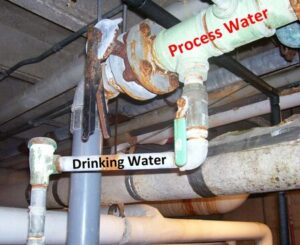
Cross-Connection Control Program

Cross-Connection Control
Program Overview
Your local water provider is making improvements to protect the safety of drinking water. Here’s why.
A cross-connection is an actual or potential connection between the safe drinking water (potable) supply, and a source of contamination or pollution. Cross-connections can result in a hazardous event known as backflow, which can draw those contaminants into your drinking water supply.
Florida Administrative Code Rule 62-555.360 prohibits hazardous interconnections to public water systems and requires all public water systems development a comprehensive Cross-Connection Control Program.
Cross-Connection and Backflow FAQ
A cross-connection is an actual or potential connection between the safe drinking water (potable) supply and a source of contamination or pollution. State plumbing codes require approved backflow prevention methods to be installed at every point of potable water connection and use. Cross-Connections must be properly protected or eliminated.

Just like any other mechanical device, backflow prevention assemblies are prone to wear and tear, and do break down from time to time. Regular testing is required in order to ensure that your device remains in proper working order.